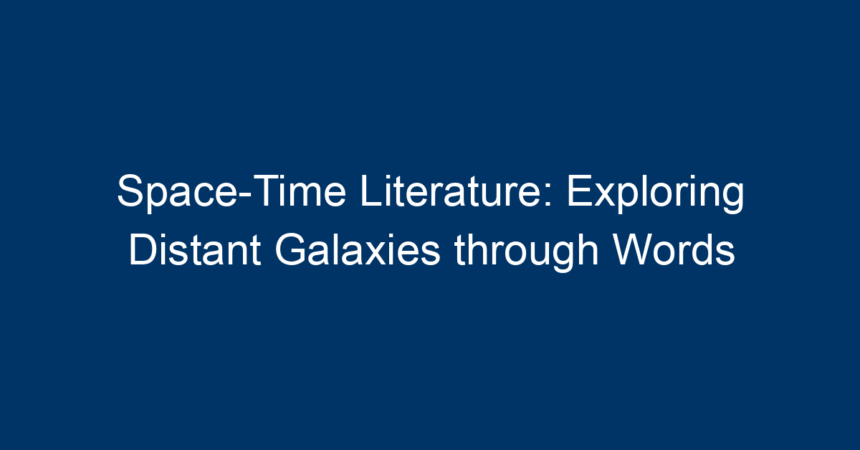In an era where our understanding of the universe expands daily, the fusion of literature and scientific thought gives rise to a captivating genre: space-time literature. This enthralling category transcends the limits of our imagination, allowing readers to explore galaxies not just through telescopes but through the art of storytelling. In this article, we’ll delve into the intricacies of space-time literature, examining its themes, notable works, and the profound connections it establishes between science and human experience.
What is Space-Time Literature?
Space-time literature embodies narratives that intertwine the vastness of space with the concept of time. This genre challenges the conventional notions of storytelling by employing non-linear timelines, multi-dimensional settings, and complex characters. It allows authors to explore intricate themes such as the nature of reality, the cosmos, existence, and humanity’s place within the universe.
The Origins of Space-Time Literature
The roots of this genre can be traced back to the early days of science fiction, where pioneers like H.G. Wells and Jules Verne began to weave intricate tales that combined imaginative science with speculative ideas. With the advancement of quantum theory and relativity, contemporary authors have taken these foundations and expanded upon them, creating rich narratives that not only entertain but also provoke thought.
Common Themes in Space-Time Literature
Space-time literature often encompasses several prominent themes that resonate with readers:
1. The Nature of Time
One of the central themes is the exploration of time itself. Authors often manipulate time, presenting paradoxes and alternate realities. Works like “The Time Traveler’s Wife” by Audrey Niffenegger and “Slaughterhouse-Five” by Kurt Vonnegut illustrate how time can be fluid, affecting relationships and perceptions.
2. The Vastness of Space
The cosmos serves as both a backdrop and a character in space-time literature. Authors depict grand explorations, alien civilizations, and the emotional struggles of characters grappling with isolation. In “The Hitchhiker’s Guide to the Galaxy” by Douglas Adams, humorous yet profound reflections on space travel present a fresh perspective on the universe.
3. Humanity’s Place in the Universe
Space-time literature dives deep into philosophical questions about existence. It examines humanity’s conscious and unconscious desires to understand its place in an expansive universe. Works like “Contact” by Carl Sagan invite readers to contemplate the implications of extraterrestrial life and our responsibility as stewards of Earth.
4. The Intersection of Science and Fiction
This genre often illustrates the fine line between science and imagination. Authors bridge the two worlds, blending scientific principles with narrative creativity. Such a fusion encourages readers to ponder: "What if?"
Notable Works in Space-Time Literature
1. "The Left Hand of Darkness" by Ursula K. Le Guin
This novel exemplifies space-time literature’s potential to challenge societal norms. Le Guin explores themes of gender and identity within a fantastical alien society, emphasizing how environment shapes social structures. Her weaving of anthropology and sci-fi provides a deeply layered narrative that resonates with contemporary discussions.
2. "Kindred" by Octavia Butler
In “Kindred,” Butler masterfully blends historical fiction with elements of time travel. The protagonist is thrust back into 19th-century America, navigating the complexities of race, identity, and survival. Through her unique approach to time travel, Butler raises crucial questions about history’s impact on the present.
3. "The Three-Body Problem" by Liu Cixin
A masterpiece of modern sci-fi, Liu’s novel examines first contact with an alien civilization while exploring themes of physics, philosophy, and human nature. The incorporation of scientific theories into a gripping narrative exemplifies the potential of space-time literature to elevate discourse around complex subjects.
Writing Techniques in Space-Time Literature
Authors of space-time literature often employ unique writing techniques to engage readers:
Non-Linear Narratives
Writers frequently present stories in a non-linear manner, allowing readers to piece together timelines akin to solving a puzzle. This technique heightens the immersive experience and encourages critical thinking.
Evocative Descriptions
Vivid imagery and evocative descriptions play a crucial role. Through rich language, authors transport readers into the vastness of outer space or the depths of an alternate reality.
Complex Characters
Characters in space-time literature often grapple with existential dilemmas, making them relatable and compelling. They reflect the complexities of human emotions when faced with the infinite and unknown.
The Impact of Space-Time Literature on Society
Space-time literature not only entertains but also challenges societal norms and encourages dialogue. It fosters a sense of connection and curiosity about the universe and our place within it. By engaging with these narratives, readers are prompted to consider pressing issues such as:
1. Climate Change and Environmental Responsibility
Many authors use their narratives to comment on ecological concerns, urging readers to reflect on humanity’s impact on the planet. This theme is particularly prevalent in works that explore dystopian futures resulting from environmental neglect.
2. Ethical Considerations in Science
Space-time literature compels us to consider the moral implications of scientific advancements. It poses questions regarding AI, genetic engineering, and space exploration, challenging readers to reflect on the responsibilities that accompany knowledge.
3. Social Justice and Equality
Through their diverse characters and settings, authors highlight issues of inequality, race, gender, and identity. This introspection fosters empathy and understanding among readers.
Conclusion: Navigating the Universe through Words
In conclusion, space-time literature serves as a gateway to understanding the universe from a deeply human perspective. It invites readers to ponder the nature of time, the expanse of space, and the ethical dilemmas arising from scientific progress. By engaging with this genre, individuals not only expand their imagination but also develop a nuanced understanding of the complexities of existence.
Actionable Insights
-
Explore Works from Diverse Authors: Read books from authors of varied backgrounds to gain different perspectives on space and time.
-
Write Your Own Space-Time Narratives: Embrace the creative process by experimenting with storytelling techniques that challenge time and space.
-
Engage in Discussions: Join book clubs or online forums to discuss themes and ideas presented in space-time literature, deepening your understanding.
- Reflect on Our Role in the Cosmos: Take time to consider your personal relationship with the universe, prompting introspection that can lead to positive change.
By immersing yourself in space-time literature, you embark on a journey that transcends the boundaries of earth and time, igniting your curiosity about the vast cosmos and your place within it.




